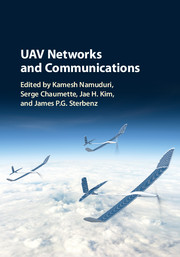Book contents
- Frontmatter
- Dedication
- Contents
- Preface
- Contributors
- 1 Introduction to UAV Systems
- 2 Air-to-Ground and Air-to-Air Data Link Communication
- 3 Aerial Wi-Fi Networks
- 4 Disruption-Tolerant Airborne Networks and Protocols
- 5 UAV Systems and Networks: Emulation and Field Demonstration
- 6 Integrating UAS into the NAS – Regulatory, Technical, and Research Challenges
- 7 Safety, Security, and Privacy Aspects in UAV Networks
- 8 Collaboration Between Autonomous Drones and Swarming
- 9 Real-World Applications
- References
- Index
8 - Collaboration Between Autonomous Drones and Swarming
Published online by Cambridge University Press: 17 November 2017
- Frontmatter
- Dedication
- Contents
- Preface
- Contributors
- 1 Introduction to UAV Systems
- 2 Air-to-Ground and Air-to-Air Data Link Communication
- 3 Aerial Wi-Fi Networks
- 4 Disruption-Tolerant Airborne Networks and Protocols
- 5 UAV Systems and Networks: Emulation and Field Demonstration
- 6 Integrating UAS into the NAS – Regulatory, Technical, and Research Challenges
- 7 Safety, Security, and Privacy Aspects in UAV Networks
- 8 Collaboration Between Autonomous Drones and Swarming
- 9 Real-World Applications
- References
- Index
Summary
Introduction and Background
Recent technological progress, especially in robotics and mechatronics, has made it possible to create autonomous mobile vehicles such as air, ground, surface, or underwater robots. All of these vehicles are referred to as drones or unmanned systems. The focus of this chapter is on air vehicles, but all these systems share a large number of characteristics independently of the environment in which they evolve. This chapter is thus useful reading whatever type of unmanned system you are interested in. Unless stated otherwise, the term drone in what follows will refer to air vehicles.We will also use the terms unmanned aerial vehicle (UAV), unmanned aerial system (UAS), and remotely piloted aircraft system (RPAS), the latter being the now official naming. It should be noted that the wording RPAS includes the notion of a remote pilot. Still, in this chapter, the focus is on autonomous systems that do not have a ground pilot, and that consequently need to make their own decisions to achieve the missions that are assigned to them. Why we consider autonomous drones will be explained a bit later in this introduction.
The technological progress additionally makes it possible to embed various sensing, actuating, and communication capabilities on board drones and it is now possible for them to not only interact with their environment (by means of sensors and actuators) but also to interact with each other (and with the ground, surface, or underwater vehicles, ground sensors, and troops). It is thus possible to consider groups of UAVs flying together and collaborating to achieve a common global mission.1 Such groups are referred to as swarms. Swarms usually assume close collaboration and close flight – even though close flight still remains a difficult problem – whereas a fleet – terminology that the reader will often find in the literature – supposes looser relationship and a notion of hierarchy between the UAVs. In this chapter, we will use both words depending on the kind of configuration we are referring to. Additionally, we are envisioning large groups of drones and since one cannot afford to have as many ground pilots as UAVs (we are talking tens or hundreds of UAVs), the UAVs we consider have to be autonomous: once launched, they manage themselves without any ground intervention.
- Type
- Chapter
- Information
- UAV Networks and Communications , pp. 177 - 193Publisher: Cambridge University PressPrint publication year: 2017
- 2
- Cited by



